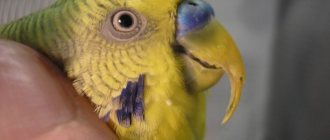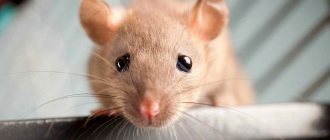Everyone knows about the short lifespan of hamsters.
And then a terrible thing happened: it seems that the pet died. Due to excitement, it is difficult to figure out what to do if the hamster lies and does not move, but is breathing. After all, the presence of breathing means that the animal is still alive. Before you run to the veterinarian, you need to try to figure out why your pet is lying motionless. Pay attention to other signs: whether the eyes are closed, how often the rodent breathes. If the eyelids are closed and breathing is calm, the hamster may simply be fast asleep.
Diseases of hamsters - oral cavity and skin
Boils. Hamster diseases
Hamster abscesses are a type of abrasion that appears mainly on the pads of hamsters' feet.
- reasons - the exact cause of the appearance of abscesses has not been found, but veterinarians are inclined to mechanical injuries;
- symptoms - the presence of abrasions on the pet’s paws, which are detected during a visual examination of the hamster;
- treatment - most often, to eliminate abscesses in hamsters, doctors prescribe the use of ointments with zinc or fish oil, or preparations based on these components. Treatment of such a seemingly minor disease can take several months, since the pads are very sensitive and are constantly exposed to stress.
Anomalies of teeth. Hamster diseases
Anomalies of teeth in hamsters - all representatives of rodents have such a feature as the constant growth of their front teeth. Because of this, the animal’s bite may be disrupted and the teeth simply do not close. This already leads to digestive disorders, etc.
- reasons - the cause of such anomalies may be genetic characteristics that imply accelerated tooth growth, or the cause may be a diet that contains very little solid food. The animal simply does not have time to grind down its teeth;
- Diseases of hamsters often spread to the teeth; the most common symptoms of dental pathologies are increased salivation. The pet may refuse food, stop gnawing food;
- treatment - to cure this type of pathology, you should not self-medicate, but seek help from a veterinarian. Often a procedure such as treating teeth with a drill is performed. If “hooks” appear on the teeth as a result of the disease, they should also be removed.
Inflammation of the cheek pouches. Hamster diseases
- reasons - inflammation of the sacs occurs if there is any damage to them on the inside. Also, if food is constantly stored there, an inflammatory process may occur due to the interaction of tissues and fibers of the products;
- symptoms - as a rule, symptoms of inflammation of the cheek pouches may be absent at all. But there may also be a decrease in appetite due to painful sensations;
- treatment - it is possible to fix the inflammation only by contacting a veterinary center, since to examine the cheeks from the inside you need to turn them out correctly. If you do not have the necessary skills, you can cause discomfort to your pet. Inflammation is treated by removing remaining food and treating with bactericidal agents.
Hair loss in hamsters
Baldness in hamsters may be confused by some owners with lichen, since they are very similar upon visual inspection. The only difference
, which can clarify the picture is the presence of scales in areas of hair loss in cases of lichen, while in cases of baldness the skin remains smooth. You should not diagnose yourself; in any case, you should consult a veterinarian.
- reasons - the causes of baldness in hamsters include the following factors: a decrease in the intake of vitamins and minerals in the body, frequent and severe stress in the pet;
- symptoms - symptoms manifest themselves in hair loss, you can also notice apathy and lethargy in your pet;
- treatment - if there is a lack of vitamins, they should be included in the hamster’s diet. If there is stress, it is necessary to exclude its occurrence.
Herpes in hamsters
Herpes in hamsters is an inflammation of the skin near the mucous tissues of the animal.
- reasons - a hamster can become infected with herpes through contact with other hamsters;
- symptoms - the disease occurs without any visible symptoms. It can be detected more often only during routine veterinary examinations;
- treatment - this disease does not require special treatment and goes away on its own in one to two weeks, but in any case, consultation with a specialist is necessary to know exactly what ailment your pet has.
Trichomonosis. Hamster diseases.
Trichomoniasis in hamsters is a disease caused by the activity of a parasite from the Trichomonas gallinae family.
- reasons - the parasite can enter your hamster’s body by drinking dirty water or bad food. Due to weak immunity, young people are especially more susceptible to trichomoniasis than adults;
- symptoms - manifested in a yellowish tint of the pharynx. Subsequently, it increases in size, as if it swells and blocks access to oxygen;
- treatment - carried out through the use of medications that should only be prescribed by a veterinarian. If you do not help your hamster in time, death is possible.
Conjunctivitis in hamsters
Conjunctivitis is also a disease of hamsters; it is a pathology associated with disruption of the mucous membrane of the eyes.
- causes - bacterial infections or colds that cause complications;
- symptoms - there may be copious discharge of mucus from the eyes;
- treatment - doctors recommend rinsing the eye mucosa with salt water or using special drops.
Is it worth waking up?
Hamster breeders do not give a clear answer to this question. You will have to make a decision yourself, based on the data presented below.
Not worth it
On the one hand, in nature, a hamster approaches hibernation consciously and with full responsibility. He conscientiously eats up the subcutaneous fat layer so that he has something to eat in his sleep.
And there is an opinion that if the hamster is not woken up, unprepared - not well fed - he may simply die in his sleep. But in nature, when he gets hungry, he wakes up and “stomps into his pantry to inspect the supplies”! What's stopping him from doing this in a cage?!
Proponents of not forcibly removing a hamster from a state of “sleepy coma” believe that all life processes in the body should occur naturally, without external gross interference. Hibernation can last from several hours to several days.
By the way, what speaks in favor of rodent hibernation at home is the fact that those of them who “switch off” in winter live longer lives than those who “don’t sleep” in the cold season. True, winter sleep in animals negatively affects the appearance of cubs: they are born less often and in smaller numbers.
If you decide not to wake your pet, help him wake up comfortably. Insulate the cage, for example, put a lot of cotton wool in it and carefully immerse the hamster in it.
Nearby, prepare a “self-assembled tablecloth” with delicacies for him, so that when he wakes up, he can refresh his strength.
Costs
The baby, numb from the cold, needs to be woken up. In making such a decision, the fact that at home there is absolutely no need for a hamster to hibernate often plays a role.
And his further rhythm of life should not be disrupted by such a random incident.
The owner corrects errors in care, “revives” the pet and no longer allows it to “fall asleep.”
Digestive diseases in hamsters
Obesity in hamsters
Obesity in a hamster - an increase in the amount of subcutaneous fat in a hamster can have a bad effect on other organs, such as the heart. By nature, the hamster is a mobile animal and needs constant exercise.
- reasons - a decrease in physical activity, often due to the fault of the owner, when living conditions do not meet the requirements;
- symptoms - a visual increase in the fat layer in the hamster. Decreased overall activity
- treatment - increasing the load, installing various treadmills and attractions in the cage. Monitoring caloric intake.
Colibacillosis. Hamster diseases
Colibacillosis in a hamster is a disease of the gastrointestinal tract, which manifests itself in its disorder. Also, this disease is called “ wet tail ”. It has a bacterial origin. This intestinal pathology can confuse owners
, since in the early stages it is similar to other diseases that are not of a bacterial nature.
- reasons - the presence of unfavorable bacteria in the body, which come from food or water;
- symptoms - the main sign is the presence of diarrhea in a hamster. Subsequently, lack of appetite, water diarrhea, aggressive conditions, bleeding are connected;
- treatment - colibacillosis can be cured only by following all the instructions and recommendations of a veterinarian. Most often, solutions containing electrolytes are used to improve the hydration process. Along with this, antibiotics are prescribed that stabilize the condition of the intestines. It is also necessary to adhere to a certain diet, which involves excluding certain foods from the diet.
Important! Colibacillosis can be transmitted to other individuals. Therefore, if you have other hamsters, they must be isolated from the infected pet.
E. coli is also a disease of hamsters
E. coli in hamsters is a disease that causes significant discomfort to the pet, even death. It is infectious in nature. As the disease progresses, the intestinal flora of the infected hamster changes due to the activity of the microbe.
- reasons - penetration of an animal microbe into the body;
- symptoms - signs of E. coli are a high body temperature in the animal and the presence of bloody diarrhea during bowel movements;
- treatment - the disease in most cases ends in death for the pet. It is very important to fix it in the early stages (which is very difficult, since it develops very quickly), in order to leave at least some chance of recovery.
Enteritis in a hamster
Enteritis in hamsters affects the organs responsible for normal digestion of the animal.
- reasons - doctors call the main factor in the development of enteritis, the lack of hay in the diet;
- symptoms: bloating and diarrhea;
- treatment looks specific. The feces of a healthy animal are taken, mixed in water and administered as an enema to the patient. It is also recommended to include hay in the diet to improve digestion.
Poisoning - diseases of hamsters
- reasons: poor quality of food consumed, presence of household chemicals on food products. Dirty or stagnant water;
- symptoms: loss of appetite, lethargy. Sometimes diarrhea and vomiting;
- treatment - a veterinarian should prescribe treatment based on the results of the examinations. It is important to distinguish poisoning from a viral infection. Failure to seek help in a timely manner can result in death.
Temperature-related disorders
If the hamster did not show the slightest signs of illness and suddenly fell into an unconscious state, it may be hibernating. In the natural environment, Djunga hamsters retire in winter, experiencing cold weather, periods of lack of food and insufficient lighting. The other extreme is overheating of the hamster, and this is much more dangerous than cooling, since the small animal is absolutely defenseless against high thermometer readings. It is overheating that most often becomes the cause of death for a rodent.
Low room temperature
Turning off the heating or leaving a window open for a long time on a frosty day can cause the hamster to fall into torpor. In this case, the body will be very cold, and the heartbeat will slow down significantly - to one beat every fifteen seconds. A sleeping hamster barely breathes and due to its small size it is quite difficult to determine how intense the breathing is and whether it exists at all. But if the body is soft to the touch, this means that the rodent is alive.
To awaken it, you need to move the cage to a room with a temperature above +20 degrees. The hamster will wake up in 2-3 days and care should be taken that the feeder and water bowl are full when he wakes up. This is especially important, since during hibernation a rodent wastes a very large amount of energy and its health will depend on how quickly it replenishes it with food. A hamster left hungry after hibernation may develop serious liver problems.
This method of awakening is optimal, since it is close to how a hamster wakes up from hibernation in its natural environment, but the process can be accelerated:
- Wrap the hamster in a warm cloth or down mitten, place it in a cage and move it to a room with a high temperature.
- Fill several bottles with hot water, place them in a row and place the cage on them. Heat will be transferred through the bottom, warming the hamster
Important! Try not to let your hamster hibernate again. To do this, you need to maintain the temperature in the room where the cage is above +20 degrees, make sure that a sufficient amount of sunlight penetrates into the hamster’s house, and that the rodent always has the necessary amount of food and drink.
Heat
Exposure to high temperatures has an extremely negative effect on hamsters. These animals have very dense fur and completely lack protection from overheating - they do not sweat and cannot breathe through their mouths.
You can tell that a hamster is overheated by the fact that it does not move and is breathing heavily, or its coordination of movements is impaired and it is generally weakened.
Heatstroke can be caused by the following situations:
- Transport by car
- A cage placed on a windowsill or balcony so that the hamster is exposed to direct sunlight
- The animal's house is located next to the heating devices
- There is not enough air in the room where the hamster is located and it is very humid
Important! Heat stroke for a hamster is most often fatal if all necessary measures are not taken very quickly.
Diseases of the genitourinary system in hamsters
Cystitis in a hamster
Cystitis in a hamster is a disease that affects the genitourinary system
- Causes - The causes of cystitis can be both mechanical damage and nutritional disorders. It is also possible that the disease may appear due to the lack of the proper amount of water in the diet;
- symptoms include frequent urination and increased anxiety;
- treatment is carried out by using drugs such as buscopan. If after a course of taking medications the condition does not improve, it is necessary to re-diagnose using x-rays.
All breeds are dormouse!
The most popular types of hamsters for home breeding include:
- Syrian;
- Djungarian;
- long-tailed;
- ordinary;
- angora.
Albino. There are also so-called albino hamsters. These are also very often kept at home. Although this is not a breed, it is a biological feature of a living organism - the absence of dark pigmentation. These hamsters are pure white with a pink nose and pink eyes.
All these hamsters are capable of falling into suspended animation, since this was typical for their ancestors under natural conditions. By the way, it has been noticed that most often hibernation at home “happens” to Syrian hamsters.
Hamster diseases - diseases of the nervous system
Lymphocytic choriomeningitis in hamsters
Lymphocytic choriomeningitis in hamsters is a very serious disease that is infectious in nature. Affects all organs.
- reasons - an animal can become infected through contact with a sick individual. The main carriers of this disease are mice;
- symptoms - appear almost immediately and are expressed in general weakness, difficulty breathing, body temperature increases;
- treatment is a disease, unfortunately incurable. If your pet has become a victim of lymphocytic choriomeningitis, measures should be taken to euthanize the hamster. This is the only way to put him out of his misery.
Important! All hygiene rules must be followed; this disease can be transmitted to humans.
Aujeszky's disease - what is important to know about this disease of hamsters
Aujeszky's disease - this disease is often called “false rabies”, since they have similar symptoms.
- reasons - the causative agent of this disease is a virus that affects the entire nervous system of the hamster;
- symptoms - signs of the disease do not appear immediately, but only after two to three weeks after infection. The disease manifests itself in increased excitability of the animal and the presence of itching;
- treatment - it is possible to cure Aujeszky's disease only in the early stages, if the disease is advanced, the virus covers the hamster's vocal cords, provokes the development of laryngeal paralysis, as a result of which the animal dies.
Sleeping or dead?
This is not difficult to determine. The main thing is to be patient.
- In a state of torpor, the hamster’s body, although cold, hard and motionless, can still hear its heartbeat. It is rare - only a few beats per minute.
- The animal also occasionally continues to inhale and exhale. Hold a mirror to its muzzle: if the hamster is alive, after some time traces of fogging will appear on the glass from its breathing.
Other diseases of hamsters
Tumor in a hamster
A tumor in a hamster is a disease caused by the appearance of a neoplasm in the body in the form of a malignant tumor.
- The reasons are genetic predisposition. Some foods may have a positive effect on the development of cancer in hamsters. Older individuals also have a tendency;
- symptoms - signs depend on the location of the tumor, they can be different organs, and symptoms are vomiting, diarrhea, impaired movement, interruptions in the functioning of the body in general, etc.;
- treatment - involves the removal of a malignant neoplasm, but only if necessary.
Hamster heart disease
A hamster has heart disease - characterized by interruptions in the functioning of this organ. They are quite rare in hamsters.
- reasons - the presence of severe stress or high air temperature, which affects the regulation of the heart muscle;
- symptoms - shortness of breath, high pulse, apathy and decreased activity;
- treatment - in the first stages of treatment, it is recommended to change the conditions of the hamster’s keeping. If this does not help, and the condition only worsens, you need to administer an injection of Effortil. Again, all treatment is prescribed strictly individually. Self-medication should be excluded.
Colds are also a hamster disease
- reasons - may be hypothermia or the effect of a virus;
- symptoms - general weakness, sneezing, nasal discharge, discharge from the eyes;
- treatment - it is recommended to give pets fruits that are saturated with liquid to prevent dehydration. If colds are started, they can develop into more serious ones.
When to sound the alarm
How to understand that a hamster is sick. If the animal is healthy, it is active, it has smooth shiny fur, clear, clean eyes and a good appetite. But if you notice that your pet is behaving unusually, take immediate action. Your hamster is sick if some of the following symptoms are noticeable:
- eats poorly or refuses food altogether;
- eyes become watery or festering;
- frequent loose stools;
- constipation, dry stool or no stool at all;
- blood dripping from the anus;
- difficulty or hoarse breathing, cough;
- nasal discharge or excessive drooling;
- wet or dull, matted fur;
- ulcers, wounds, peeling skin, bald spots on the skin;
- tumors, bloating;
- lethargy, low mobility;
- the hamster is trembling, although the room is warm.
An animal's underweight may also be a sign of illness. To find out if your pet is sick, weigh your pet periodically. The weight of an adult Syrian is about 90 g, the weight of a Djungarian is at least 30 g.
Interesting facts: who hibernates and how
- The females of some animals “turn off their bodies” during pregnancy. When the time comes to give birth, their hibernation ends.
- Zoologists distinguish three types of hibernation among our smaller brothers: daily - it is characteristic of bats and hummingbirds, irregular - long sleep occurs in conditions unfavorable for normal existence, and seasonal.
- The ancient encyclopedist believed that even swallows could hibernate. However, recent studies have shown that among birds, hibernation in the full sense of the word (not daily torpor, but long-term sleep) is characteristic only of the white-throated nightjar.
- The cause of suspended animation in animals can be not only a decrease in air temperature, but also an increase. So, with the onset of winter temperatures in Madagascar above +30 degrees. The dwarf lemur climbs into a secluded hollow and prepares for a seven-month rest.
- Rodents store huge amounts of food during hibernation. The weight of the food can reach from 20 to... 90 kg, like that of a common hamster!
- During the period of suspended animation, some frogs cool down so much that they almost turn into a lump of ice. But with an increase in temperature, all vital functions resume.











